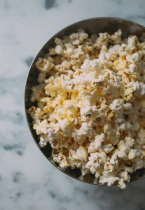Small Changes, Big Impact: A Guide to Healthy Eating and Finding Your Inner Action Hero.

Healthy choices: A labor of love and pain
Making healthy choices can be challenging for many of us. It requires effort, time, and often times, some sacrifice. However, according to nutrition expert Stephanie Middleberg, it’s a labor of love and pain that’s worth it. In her recent video, Stephanie emphasizes the importance of healthy choices, connecting through cooking, and making small changes that can lead to big differences.
Connecting through cooking: An essential edible conversation
For Stephanie, cooking is not just about nourishing the body, but also about connecting with loved ones. As a mother of two, she understands the importance of spending time in the kitchen and sharing meals with family and friends. Stephanie encourages everyone to start having an essential edible conversation, one that centers around healthy eating habits and the importance of making informed food choices. Through these conversations, we can create a culture of health and wellness that can benefit us all.
Small changes, big differences: Make health your bottom line
Stephanie understands that making drastic changes to our diets and lifestyles can be overwhelming. That’s why she encourages small changes that can make a big difference. By making health our bottom line and committing to change, we can gradually incorporate healthier habits into our daily routines. This could mean starting with something as simple as replacing soda with water or choosing a healthier option at the grocery store. These small changes can add up over time and lead to significant improvements in our health and wellbeing.
In conclusion, making healthy choices may be a labor of love and pain, but it’s a necessary step towards living a fulfilling and healthy life. By connecting through cooking and making small changes, we can create a culture of health and wellness that benefits us all. So let’s start having those essential edible conversations, and let’s make health our bottom line.
The importance of questioning food choices
Have you ever looked at the ingredients list on your food packaging and felt confused or uncertain about what you’re putting into your body? You’re not alone. Stephanie Middleberg, a nutrition expert, emphasizes the importance of questioning our food choices to ensure that we are making informed decisions that support our health and wellbeing.
Barriers to healthy eating: Time, cost, access, and confusion
One of the biggest barriers to healthy eating is the lack of time. Between work, school, and other commitments, finding time to prepare healthy meals can be a challenge. Another common barrier is the cost of healthy food, which can often be more expensive than processed and unhealthy options. Access to healthy food can also be a challenge for those living in food deserts or areas without easy access to fresh produce. Finally, confusion about what is actually healthy and what is not can make it difficult to make informed food choices.
Planning for nourishment: A simple solution
Despite these barriers, Stephanie believes that planning for nourishment is a simple solution that can help overcome many of the challenges associated with healthy eating. By taking the time to plan meals and snacks ahead of time, we can ensure that we have healthy options available when we need them. This can be as simple as making a shopping list, planning meals for the week, and carving out time for cooking and meal preparation. By making nourishment a priority, we can make it easier to make healthy choices and ensure that we are supporting our health and wellbeing.
In conclusion, questioning our food choices and making informed decisions is crucial for our health and wellbeing. While there are barriers to healthy eating, planning for nourishment is a simple solution that can help overcome many of these challenges. By prioritizing our health and making small changes, we can make a big impact on our overall wellbeing. So take the time to plan, question your food choices, and make informed decisions that support your health and happiness.
Accessible options for healthy eating
Eating healthy doesn’t have to be expensive or inaccessible. In fact, there are many options available that make it easy to prioritize our health and wellbeing without breaking the bank.
Healthy eating on a budget: Dispelling the myth
One of the biggest myths about healthy eating is that it is expensive. While it is true that some healthy food options can be more expensive, there are many affordable choices available as well. For example, purchasing fresh produce in season or frozen fruits and vegetables can be more affordable than buying out of season or pre-cut options. Similarly, opting for whole grains and legumes can be a cost-effective way to add protein and fiber to meals.
Becoming a skeptical shopper: Questioning the foods you choose
Another important aspect of accessible healthy eating is becoming a skeptical shopper. This means questioning the foods we choose and making informed decisions about what we put into our bodies. One way to do this is by reading ingredient labels and avoiding products with artificial additives or high amounts of sugar, sodium, or unhealthy fats. Additionally, using resources such as the Environmental Working Group’s Food Scores database can help us make informed choices about the foods we purchase and consume.
By prioritizing our health and becoming more mindful shoppers, we can make healthy eating more accessible and affordable. By opting for whole foods and questioning the foods we choose, we can ensure that we are nourishing our bodies with the nutrients we need to thrive.
In conclusion, accessible options for healthy eating are available to all of us. By dispelling the myth that healthy eating is expensive, and becoming more mindful shoppers, we can prioritize our health and wellbeing without breaking the bank. So take the time to research affordable options, read ingredient labels, and make informed choices that support your health and happiness.
The pantry, fridge, freezer rehab: Finding better alternatives
One of the keys to healthy eating is having access to nutritious foods at home. This means taking a closer look at what we have in our pantry, fridge, and freezer and making changes to support our health and wellbeing.
Cooking for health: Nutritious meets delicious
Finding better alternatives in our pantry, fridge, and freezer can help us make nutritious and delicious meals at home. This means swapping out highly processed and unhealthy options for whole foods and fresh ingredients. For example, we can replace sugary cereals with whole grain options, swap out canned soups for homemade versions, and choose fresh fruits and vegetables over pre-packaged snacks. By cooking at home and using fresh, whole ingredients, we can nourish our bodies with the nutrients we need to thrive.
Finding your inner action hero: Making a difference in your health
Making changes to our pantry, fridge, and freezer can be a challenge, but it’s an important step towards better health and wellbeing. By finding our inner action hero and taking charge of our health, we can make lasting changes that benefit our bodies and minds. This means taking small steps, such as reading ingredient labels, planning meals in advance, and experimenting with new recipes and ingredients.
Ultimately, the pantry, fridge, and freezer rehab is about finding better alternatives and making conscious choices about what we consume. By prioritizing our health and wellbeing, we can make lasting changes that improve our quality of life and support our long-term health goals.
In conclusion, the pantry, fridge, and freezer rehab is an important step towards healthier eating and living. By finding better alternatives and cooking with fresh, whole ingredients, we can nourish our bodies and minds and make a positive impact on our health. So take charge of your health, find your inner action hero, and start making small changes today that will lead to a healthier, happier tomorrow.
Conclusion
In conclusion, making healthy food choices can be a labor of love and pain, but it’s a necessary step towards improving our health and wellbeing. By connecting through cooking and having essential edible conversations, we can make small changes that have a big impact on our everyday lives.
However, there are barriers to healthy eating, including time, cost, access, and confusion. Despite these challenges, planning for nourishment and questioning our food choices can help us overcome these barriers and make healthier choices for ourselves and our loved ones.
Thankfully, there are accessible options for healthy eating, and it’s important to dispel the myth that healthy eating is expensive. By becoming skeptical shoppers and looking for better alternatives in our pantry, fridge, and freezer, we can make nutritious and delicious meals at home.
The pantry, fridge, and freezer rehab is a great place to start, and by finding our inner action hero, we can take charge of our health and make positive changes that benefit our bodies and minds. With small changes and a commitment to making health our bottom line, we can all start to get an edible education and lead happier, healthier lives.













